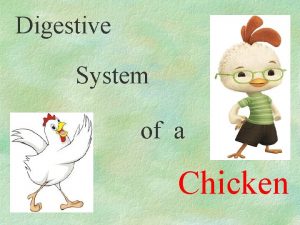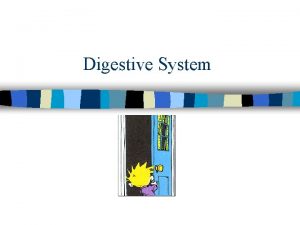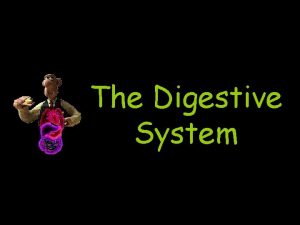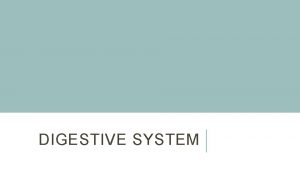THE DIGESTIVE SYSTEM The Digestive System The digestive

















- Slides: 17

THE DIGESTIVE SYSTEM

The Digestive System Ø The digestive system takes in food, digests it, absorbs nutrients and water, and excretes waste. Ø Digestive system breaks food down into nutrients, which are absorbed and transported by circulatory system. Ø There are four stages of food processing: Ø Ingestion – taking in of nutrients (food). Ø Digestion – breakdown of food (physical & chemical) Ø Absorption – taking up of digested molecules into cells of digestive tract. Ø Egestion – removal of waste food materials from body.

The Digestive Tract Ø In most animals, the digestive tract is a long tube with two openings, one at either end. Ø In humans, the digestive tract consists of the mouth, esophagus, stomach, small intestine, large intestine, and anus. Ø The digestive tract includes epithelial tissue (produces mucus), smooth muscle tissue, nerves, and connective tissue. The smooth muscle tissue can contract and relax without conscious thought.

The Mouth Digestion begins in the mouth where food is broken down both mechanically (teeth and tongue) and chemically (with enzymes found in saliva that break apart the molecules of food). The tongue moves the food to form a bolus Epiglottis receives food and air; a flap-like structure ensures food travels down esophagus

The Esophagus Ø The esophagus is a tube consisting of smooth muscle tissue that connects your mouth to your stomach. Ø The contractions of the smooth muscle (known as peristalsis) slowly moves the food along down the esophagus and into the stomach

The Stomach The main function of the stomach is to hold food and to further break it down by churning it (physical digestion) and with digestive enzymes (chemical digestion).

Ø Movement of food in & out by sphincters. Ø J-shaped stomach has 3 muscles layers to contract, relax, & churn partly digested food. Ø Stomach cells secrete gastric juice (mixture of hydrochloric acid & enzymes) and mucus. Ø Mucus protects stomach lining from being digested by gastric juices. Ø Some absorption of water, medicines (aspirin), and alcohol. Ø Active enzyme pepsin breaks down proteins

The Intestine Ø The intestine consists of: the small intestine and the large intestine. Ø Most digestion occurs in the small intestine which is about 6 m long and is relatively narrow. Ø Nutrients (from broken down food) diffuse through the wall of the small intestine into the bloodstream. Ø Up to 7 m in length stretched out; only 2. 5 cm diameter.

The Intestine Ø Partial digestion of food, chyme enters small intestine Ø Most chemical digestion takes place in first 25 -cm of the duodenum. Ø Peptidases in small intestine complete the digestion of protein Ø Small intestine secretes maltase to complete breakdown of carbohydrates.

Products of Digestion Three macromolecules broken down: Ø Carbohydrates glucose Ø Proteins amino acids Ø Fats fatty acids & glycerol • Food also supplies vitamins & minerals. • All nutrients absorbed into the bloodstream

Absorption—Small and Large Intestine Ø Most absorption in small intestine. Ø Villi increase surface area up to 10 times. Ø Large intestine (colon) is 1. 5 m long and has twice the diameter as small intestine. Ø Main function is to absorb water, salt & other usable material. Ø Bacteria produce vitamin K and some vitamin B.

Egestion—Large Intestine Ø Cellulose reaches large intestine undigested. Ø Cellulose main component of feces, along with living and dead bacteria and water. Ø Lack of cellulose may mean fewer bowel movements— risk of developing colon cancer.

Accessory Organs Ø The accessory organs are the liver, the gall bladder, and the pancreas. They produce enzymes and other fluids (such as bile) that aid digestion. Liver Ø Liver produces bile—breaks down fats. Ø Bile secreted continuously, stored in gallbladder. Ø Liver detoxifies harmful substances (alcohol).

Gall Bladder Ø The gall bladder holds bile produced by the liver until the body needs it to break down fatty foods in the duodenum of the small intestine. Ø It is located below the right lobe of the liver. Ø Gallstones are hard, pebble-like deposits that form inside the gallbladder. Gallstones may be as small as a grain of sand or as large as a golf ball. Caused by cholesterol, diabetes and liver problems.

Pancreas Ø Pancreas secretes digestive enzymes: lipase, trypsin, and pancreatic amylase Ø Pancreas also produces sodium bicarbonate raises p. H of chyme from 2. 5 to 9. 0 Ø The pancreas produces an enzyme called insulin. Insulin regulates the concentration of glucose (a sugar) in the blood. Ø Diabetes is a disease in which the pancreas produces too much or too little insulin.

Ø Diabetes is a lifelong (chronic) disease in which there are high levels of sugar in the blood. Insulin is a hormone produced by the pancreas to control blood sugar. Diabetes can be caused by too little insulin, resistance to insulin, or both.

Digestion and Homeostasis Ø Nervous, endocrine, circulatory, and digestive systems all control digestion. Ø Large meals cause more forceful stomach contractions and faster emptying. Ø Fatty meals slow peristalsis, allowing more time for fat to be absorbed.
 Site:slidetodoc.com
Site:slidetodoc.com Nervous system and digestive system
Nervous system and digestive system Hình ảnh bộ gõ cơ thể búng tay
Hình ảnh bộ gõ cơ thể búng tay Frameset trong html5
Frameset trong html5 Bổ thể
Bổ thể Tỉ lệ cơ thể trẻ em
Tỉ lệ cơ thể trẻ em Chó sói
Chó sói Glasgow thang điểm
Glasgow thang điểm Hát lên người ơi
Hát lên người ơi Môn thể thao bắt đầu bằng chữ f
Môn thể thao bắt đầu bằng chữ f Thế nào là hệ số cao nhất
Thế nào là hệ số cao nhất Các châu lục và đại dương trên thế giới
Các châu lục và đại dương trên thế giới Công thức tiính động năng
Công thức tiính động năng Trời xanh đây là của chúng ta thể thơ
Trời xanh đây là của chúng ta thể thơ Mật thư anh em như thể tay chân
Mật thư anh em như thể tay chân 101012 bằng
101012 bằng độ dài liên kết
độ dài liên kết Các châu lục và đại dương trên thế giới
Các châu lục và đại dương trên thế giới

































